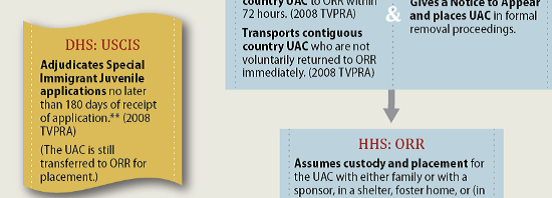I have read countless documents, court rulings, studies and interviews as the matter of the incursion at the Southern border has many moving parts. I will make this easy for the reader.
CRS Insights Unaccompanied Alien Children: A Processing Flow Chart
Lisa Seghetti, Section Research Manager ([email protected], 7-4669)
July 16, 2014 (IN10107)
Within the Departments of Homeland Security and Health and Human Services, several agencies are involved in apprehending, processing, placing, and repatriating unaccompanied alien children (UAC). Customs and Border Protection (CBP) apprehends, processes, and detains the majority of UAC arrested along U.S. borders. Immigration and Customs Enforcement (ICE) physically transports UAC from CBP to the Department of Health and Human Services Office of Refugee Resettlement (ORR) custody. ORR is responsible for detaining and sheltering UAC who are from non-contiguous countries and those from contiguous countries (i.e., Canada and Mexico) for whom there is a concern that they may be victims of trafficking or have an asylum claim, or who do not desire to return to their country voluntarily, while they wait for their claim to be processed or for an immigration hearing. U.S. Citizenship and Immigration Services (USCIS) is responsible for the initial adjudication of asylum applications and processes trafficking petitions filed by UAC. The Executive Office for Immigration Review (i.e., immigration courts) in the U.S. Department of Justice conducts the immigration proceedings that determine whether the UAC is allowed to remain in the United States or is deported to his or her home country. If a UAC is ordered removed or chooses to voluntarily depart from the United States, ICE is responsible for returning the alien to his/her home country. For an overview on this topic, see CRS Report R43599, Unaccompanied Alien Children: An Overview.
Figure 1.Unaccompanied Alien Children
A Processing Flow Chart Full graphic can be seen here.
But as Governor Perry deploys 1000 National Guard on parts of the Texas border, what does that mean and what will/can they do?
The Secretary of the Department of Homeland Security (DHS) is charged with preventing the entry of terrorists, securing the borders, and carrying out immigration enforcement functions. U.S. Customs and Border Protection (CBP), a component of DHS, has primary responsibility for securing the borders of the United States, preventing terrorists and their weapons from entering the United States, and enforcing hundreds of U.S. trade and immigration laws. Within CBP, the U.S. Border Patrol’s mission is to detect and prevent the illegal entry of aliens across the nearly 7,000 miles of Mexican and Canadian international borders and 2,000 miles of coastal borders surrounding Florida and Puerto Rico.
Although the military does not have primary responsibility to secure the borders, the Armed Forces generally provide support to law enforcement and immigration authorities along the southern border. Reported escalations in criminal activity and illegal immigration, however, have prompted some lawmakers to reevaluate the extent and type of military support that occurs in the border region. On May 25, 2010, President Obama announced that up to 1,200 National Guard troops would be sent to the border to support the Border Patrol. Addressing domestic laws and activities with the military, however, might run afoul of the Posse Comitatus Act (PCA), which prohibits use of the Armed Forces to perform the tasks of civilian law enforcement unless explicitly authorized. There are alternative legal authorities for deploying the National Guard, and the precise scope of permitted activities and funds may vary with the authority exercised.
Justice Scalia wrote the opinion in the case of Flores v. Reno the basis for where we are today with processing, shelters, detention and deportation.
The number of UACs in the Rio Grande Valley/Harlingen Field Office geographical area has seen an increase of 367.6 percent since fiscal year 2011.
Most UACs are Other Than Mexican (OTM) nationals, which causes significant increases in processing time (administrative/criminal casework) and requirements for long term detention.
The amount of time and resources needed to provide humanitarian care is extensive and increases with escalating UAC numbers.
ORR tries to place apprehended UACs as close to the referring location as possible to minimize travel requirements for CBP and ICE.
The HHS ORR Intake Center operates 24-7 but makes UAC referral placements from 9 a.m. – 9 p.m. each day.
Each morning the HHS ORR Intake Center has approximately 30-90 initial placement referral requests pending from the previous night.
The national discharge rate of UACs is approximately 80-90 per day.
There are approximately 5,000 beds available in the HHS ORR network that service approximately 25,000 UACs annually.
Each agency uses different data systems to manage UACs.


